Leadership and Management: Roles, Approaches, and Operational Impact
VerifiedAdded on 2020/07/22
|14
|4184
|80
Report
AI Summary
This report delves into the distinctions between leadership and management, using Mark & Spencer as a case study. It compares the roles and characteristics of leaders and managers, highlighting the importance of positive attitudes, innovation, communication, delegation, and decisiveness. The report examines the functions of managers, including setting objectives, motivating employees, organizing tasks, and developing people, alongside the roles of leaders in team building, guiding team members, and problem-solving. It then contrasts the roles of leaders and managers in various situational contexts, such as customer relations, supplier management, government regulations, and employee development. Furthermore, it explores different leadership theories, including situational, systems, and contingency leadership, evaluating their strengths and weaknesses. The report also addresses key approaches to operations management, such as Just-in-Time, and the roles of leaders and managers in improving operational efficiency and adapting to environmental factors.
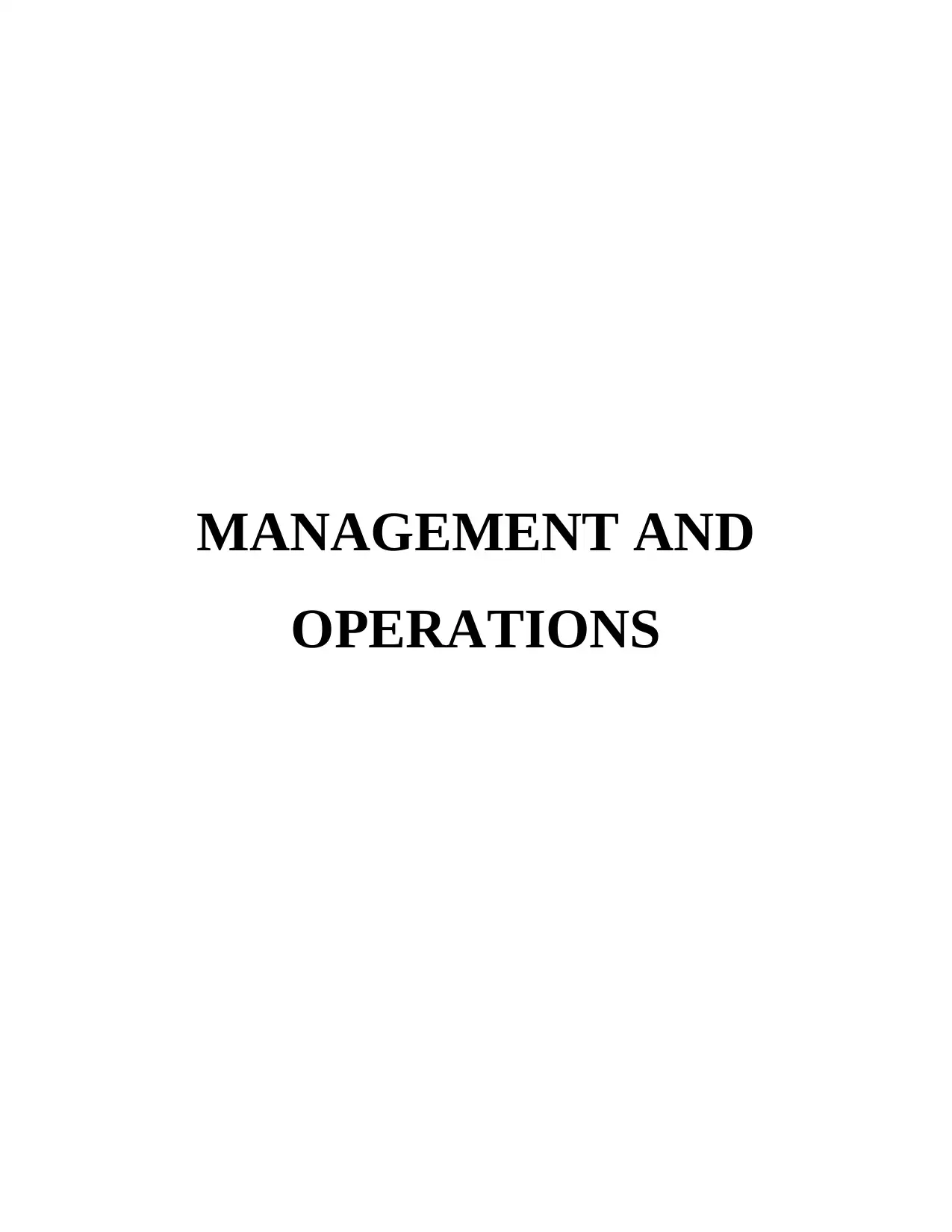
MANAGEMENT AND
OPERATIONS
OPERATIONS
Paraphrase This Document
Need a fresh take? Get an instant paraphrase of this document with our AI Paraphraser
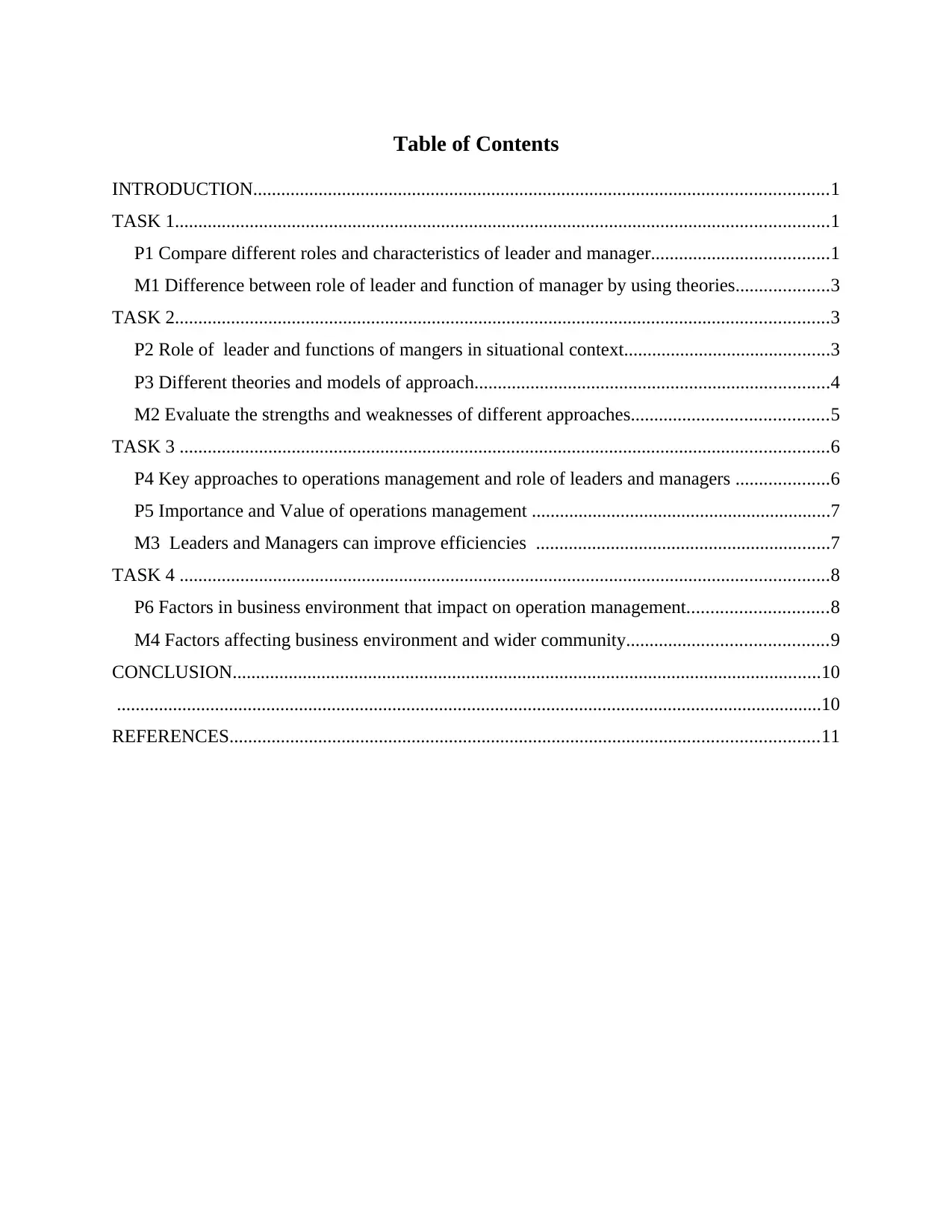
Table of Contents
INTRODUCTION...........................................................................................................................1
TASK 1............................................................................................................................................1
P1 Compare different roles and characteristics of leader and manager......................................1
M1 Difference between role of leader and function of manager by using theories....................3
TASK 2............................................................................................................................................3
P2 Role of leader and functions of mangers in situational context............................................3
P3 Different theories and models of approach............................................................................4
M2 Evaluate the strengths and weaknesses of different approaches..........................................5
TASK 3 ...........................................................................................................................................6
P4 Key approaches to operations management and role of leaders and managers ....................6
P5 Importance and Value of operations management ................................................................7
M3 Leaders and Managers can improve efficiencies ...............................................................7
TASK 4 ...........................................................................................................................................8
P6 Factors in business environment that impact on operation management..............................8
M4 Factors affecting business environment and wider community...........................................9
CONCLUSION..............................................................................................................................10
.......................................................................................................................................................10
REFERENCES..............................................................................................................................11
INTRODUCTION...........................................................................................................................1
TASK 1............................................................................................................................................1
P1 Compare different roles and characteristics of leader and manager......................................1
M1 Difference between role of leader and function of manager by using theories....................3
TASK 2............................................................................................................................................3
P2 Role of leader and functions of mangers in situational context............................................3
P3 Different theories and models of approach............................................................................4
M2 Evaluate the strengths and weaknesses of different approaches..........................................5
TASK 3 ...........................................................................................................................................6
P4 Key approaches to operations management and role of leaders and managers ....................6
P5 Importance and Value of operations management ................................................................7
M3 Leaders and Managers can improve efficiencies ...............................................................7
TASK 4 ...........................................................................................................................................8
P6 Factors in business environment that impact on operation management..............................8
M4 Factors affecting business environment and wider community...........................................9
CONCLUSION..............................................................................................................................10
.......................................................................................................................................................10
REFERENCES..............................................................................................................................11
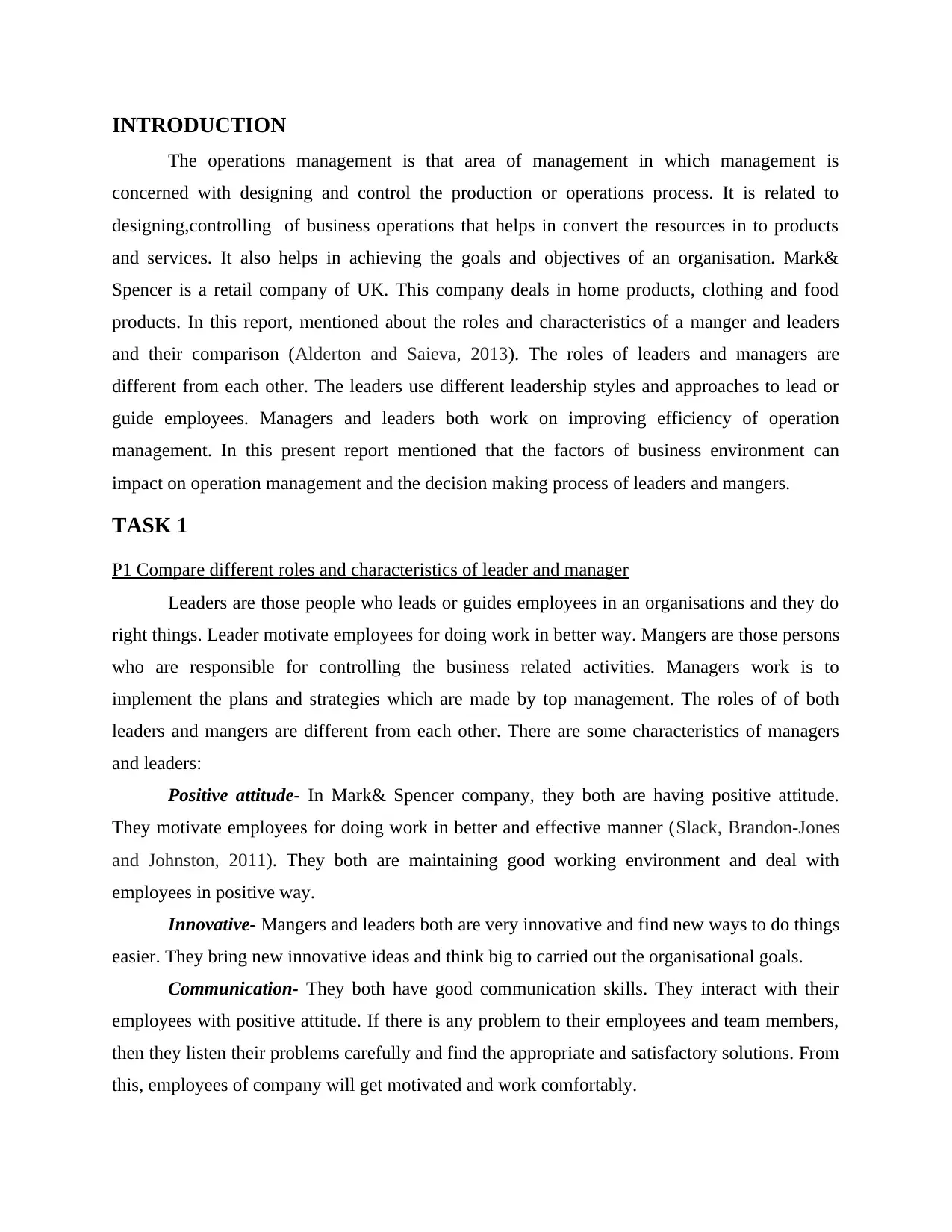
INTRODUCTION
The operations management is that area of management in which management is
concerned with designing and control the production or operations process. It is related to
designing,controlling of business operations that helps in convert the resources in to products
and services. It also helps in achieving the goals and objectives of an organisation. Mark&
Spencer is a retail company of UK. This company deals in home products, clothing and food
products. In this report, mentioned about the roles and characteristics of a manger and leaders
and their comparison (Alderton and Saieva, 2013). The roles of leaders and managers are
different from each other. The leaders use different leadership styles and approaches to lead or
guide employees. Managers and leaders both work on improving efficiency of operation
management. In this present report mentioned that the factors of business environment can
impact on operation management and the decision making process of leaders and mangers.
TASK 1
P1 Compare different roles and characteristics of leader and manager
Leaders are those people who leads or guides employees in an organisations and they do
right things. Leader motivate employees for doing work in better way. Mangers are those persons
who are responsible for controlling the business related activities. Managers work is to
implement the plans and strategies which are made by top management. The roles of of both
leaders and mangers are different from each other. There are some characteristics of managers
and leaders:
Positive attitude- In Mark& Spencer company, they both are having positive attitude.
They motivate employees for doing work in better and effective manner (Slack, Brandon-Jones
and Johnston, 2011). They both are maintaining good working environment and deal with
employees in positive way.
Innovative- Mangers and leaders both are very innovative and find new ways to do things
easier. They bring new innovative ideas and think big to carried out the organisational goals.
Communication- They both have good communication skills. They interact with their
employees with positive attitude. If there is any problem to their employees and team members,
then they listen their problems carefully and find the appropriate and satisfactory solutions. From
this, employees of company will get motivated and work comfortably.
The operations management is that area of management in which management is
concerned with designing and control the production or operations process. It is related to
designing,controlling of business operations that helps in convert the resources in to products
and services. It also helps in achieving the goals and objectives of an organisation. Mark&
Spencer is a retail company of UK. This company deals in home products, clothing and food
products. In this report, mentioned about the roles and characteristics of a manger and leaders
and their comparison (Alderton and Saieva, 2013). The roles of leaders and managers are
different from each other. The leaders use different leadership styles and approaches to lead or
guide employees. Managers and leaders both work on improving efficiency of operation
management. In this present report mentioned that the factors of business environment can
impact on operation management and the decision making process of leaders and mangers.
TASK 1
P1 Compare different roles and characteristics of leader and manager
Leaders are those people who leads or guides employees in an organisations and they do
right things. Leader motivate employees for doing work in better way. Mangers are those persons
who are responsible for controlling the business related activities. Managers work is to
implement the plans and strategies which are made by top management. The roles of of both
leaders and mangers are different from each other. There are some characteristics of managers
and leaders:
Positive attitude- In Mark& Spencer company, they both are having positive attitude.
They motivate employees for doing work in better and effective manner (Slack, Brandon-Jones
and Johnston, 2011). They both are maintaining good working environment and deal with
employees in positive way.
Innovative- Mangers and leaders both are very innovative and find new ways to do things
easier. They bring new innovative ideas and think big to carried out the organisational goals.
Communication- They both have good communication skills. They interact with their
employees with positive attitude. If there is any problem to their employees and team members,
then they listen their problems carefully and find the appropriate and satisfactory solutions. From
this, employees of company will get motivated and work comfortably.
⊘ This is a preview!⊘
Do you want full access?
Subscribe today to unlock all pages.

Trusted by 1+ million students worldwide
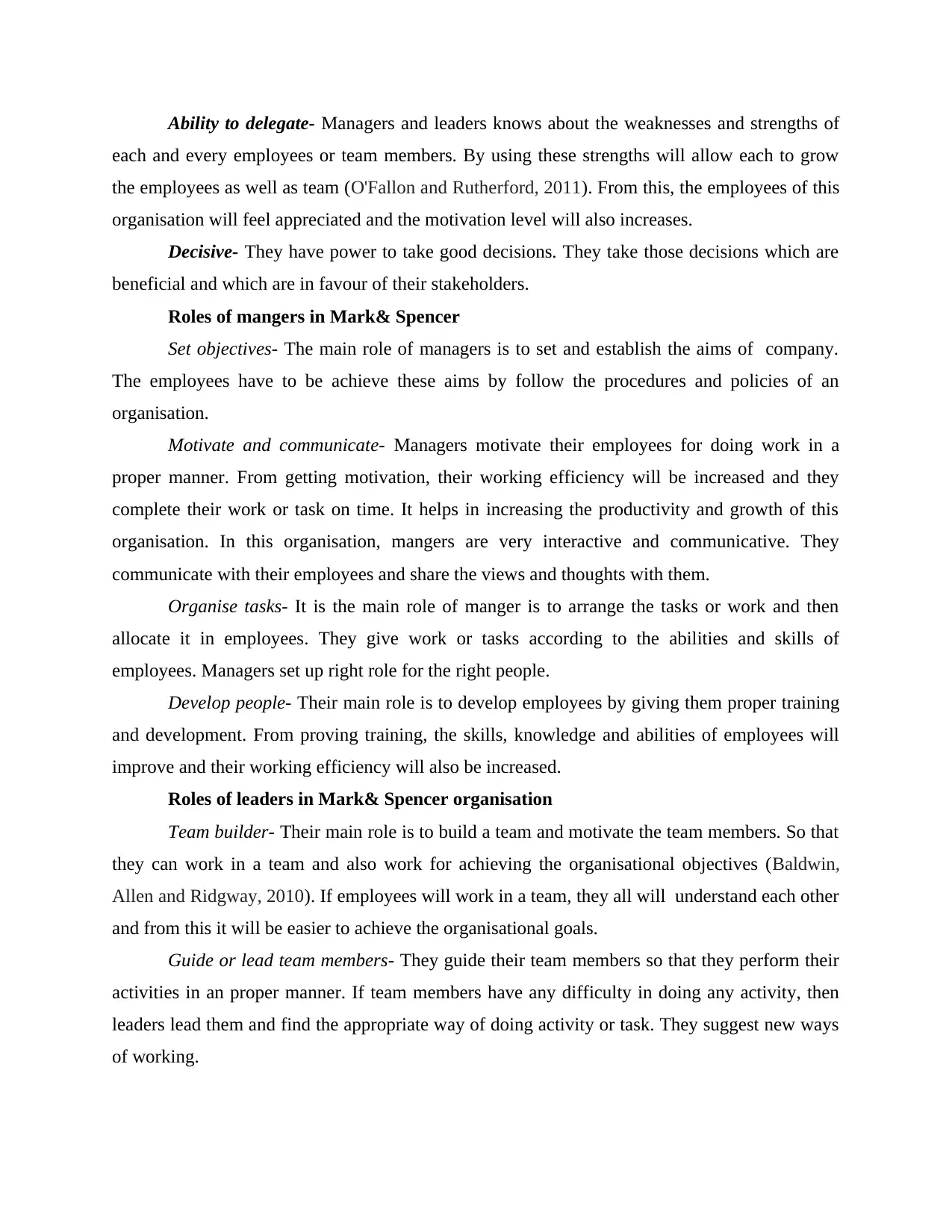
Ability to delegate- Managers and leaders knows about the weaknesses and strengths of
each and every employees or team members. By using these strengths will allow each to grow
the employees as well as team (O'Fallon and Rutherford, 2011). From this, the employees of this
organisation will feel appreciated and the motivation level will also increases.
Decisive- They have power to take good decisions. They take those decisions which are
beneficial and which are in favour of their stakeholders.
Roles of mangers in Mark& Spencer
Set objectives- The main role of managers is to set and establish the aims of company.
The employees have to be achieve these aims by follow the procedures and policies of an
organisation.
Motivate and communicate- Managers motivate their employees for doing work in a
proper manner. From getting motivation, their working efficiency will be increased and they
complete their work or task on time. It helps in increasing the productivity and growth of this
organisation. In this organisation, mangers are very interactive and communicative. They
communicate with their employees and share the views and thoughts with them.
Organise tasks- It is the main role of manger is to arrange the tasks or work and then
allocate it in employees. They give work or tasks according to the abilities and skills of
employees. Managers set up right role for the right people.
Develop people- Their main role is to develop employees by giving them proper training
and development. From proving training, the skills, knowledge and abilities of employees will
improve and their working efficiency will also be increased.
Roles of leaders in Mark& Spencer organisation
Team builder- Their main role is to build a team and motivate the team members. So that
they can work in a team and also work for achieving the organisational objectives (Baldwin,
Allen and Ridgway, 2010). If employees will work in a team, they all will understand each other
and from this it will be easier to achieve the organisational goals.
Guide or lead team members- They guide their team members so that they perform their
activities in an proper manner. If team members have any difficulty in doing any activity, then
leaders lead them and find the appropriate way of doing activity or task. They suggest new ways
of working.
each and every employees or team members. By using these strengths will allow each to grow
the employees as well as team (O'Fallon and Rutherford, 2011). From this, the employees of this
organisation will feel appreciated and the motivation level will also increases.
Decisive- They have power to take good decisions. They take those decisions which are
beneficial and which are in favour of their stakeholders.
Roles of mangers in Mark& Spencer
Set objectives- The main role of managers is to set and establish the aims of company.
The employees have to be achieve these aims by follow the procedures and policies of an
organisation.
Motivate and communicate- Managers motivate their employees for doing work in a
proper manner. From getting motivation, their working efficiency will be increased and they
complete their work or task on time. It helps in increasing the productivity and growth of this
organisation. In this organisation, mangers are very interactive and communicative. They
communicate with their employees and share the views and thoughts with them.
Organise tasks- It is the main role of manger is to arrange the tasks or work and then
allocate it in employees. They give work or tasks according to the abilities and skills of
employees. Managers set up right role for the right people.
Develop people- Their main role is to develop employees by giving them proper training
and development. From proving training, the skills, knowledge and abilities of employees will
improve and their working efficiency will also be increased.
Roles of leaders in Mark& Spencer organisation
Team builder- Their main role is to build a team and motivate the team members. So that
they can work in a team and also work for achieving the organisational objectives (Baldwin,
Allen and Ridgway, 2010). If employees will work in a team, they all will understand each other
and from this it will be easier to achieve the organisational goals.
Guide or lead team members- They guide their team members so that they perform their
activities in an proper manner. If team members have any difficulty in doing any activity, then
leaders lead them and find the appropriate way of doing activity or task. They suggest new ways
of working.
Paraphrase This Document
Need a fresh take? Get an instant paraphrase of this document with our AI Paraphraser
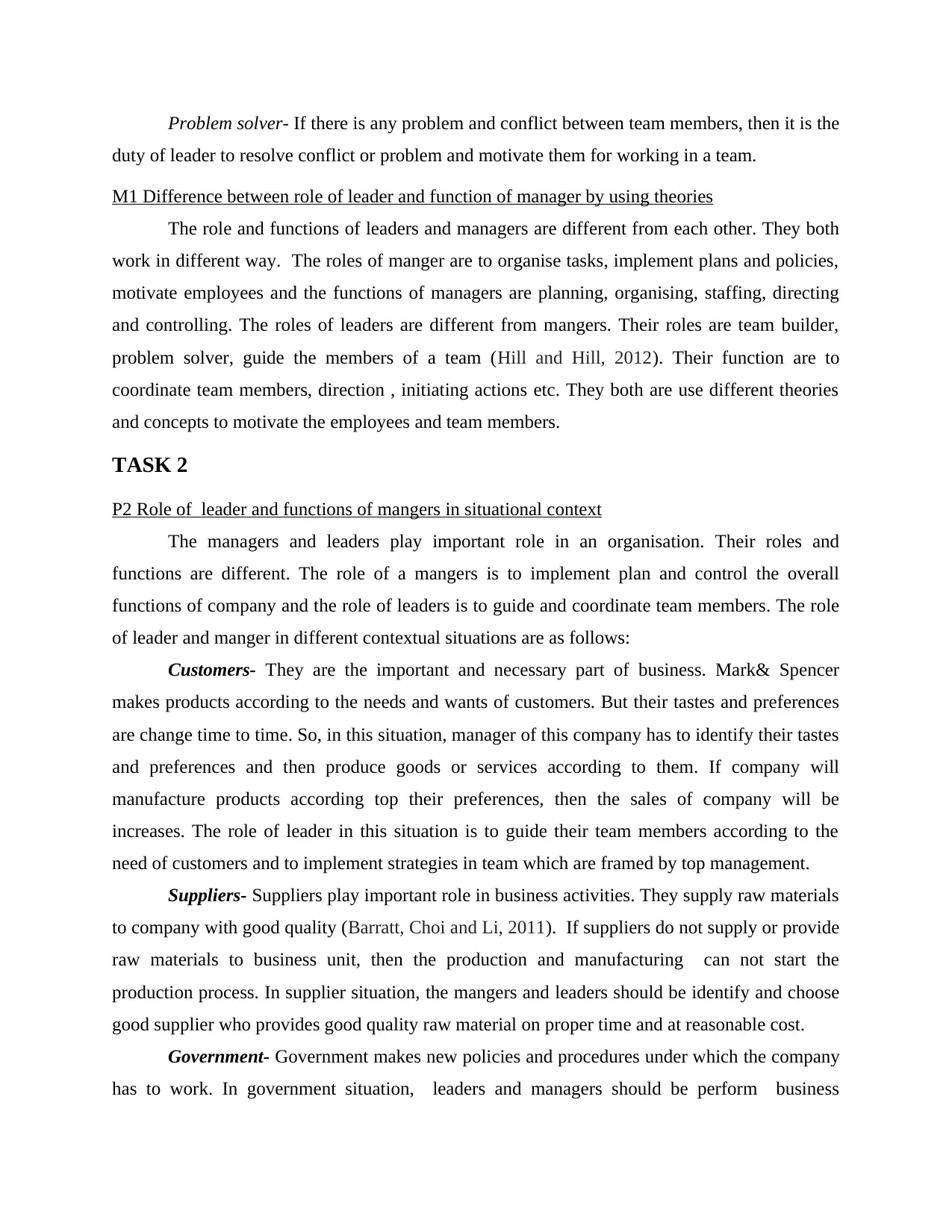
Problem solver- If there is any problem and conflict between team members, then it is the
duty of leader to resolve conflict or problem and motivate them for working in a team.
M1 Difference between role of leader and function of manager by using theories
The role and functions of leaders and managers are different from each other. They both
work in different way. The roles of manger are to organise tasks, implement plans and policies,
motivate employees and the functions of managers are planning, organising, staffing, directing
and controlling. The roles of leaders are different from mangers. Their roles are team builder,
problem solver, guide the members of a team (Hill and Hill, 2012). Their function are to
coordinate team members, direction , initiating actions etc. They both are use different theories
and concepts to motivate the employees and team members.
TASK 2
P2 Role of leader and functions of mangers in situational context
The managers and leaders play important role in an organisation. Their roles and
functions are different. The role of a mangers is to implement plan and control the overall
functions of company and the role of leaders is to guide and coordinate team members. The role
of leader and manger in different contextual situations are as follows:
Customers- They are the important and necessary part of business. Mark& Spencer
makes products according to the needs and wants of customers. But their tastes and preferences
are change time to time. So, in this situation, manager of this company has to identify their tastes
and preferences and then produce goods or services according to them. If company will
manufacture products according top their preferences, then the sales of company will be
increases. The role of leader in this situation is to guide their team members according to the
need of customers and to implement strategies in team which are framed by top management.
Suppliers- Suppliers play important role in business activities. They supply raw materials
to company with good quality (Barratt, Choi and Li, 2011). If suppliers do not supply or provide
raw materials to business unit, then the production and manufacturing can not start the
production process. In supplier situation, the mangers and leaders should be identify and choose
good supplier who provides good quality raw material on proper time and at reasonable cost.
Government- Government makes new policies and procedures under which the company
has to work. In government situation, leaders and managers should be perform business
duty of leader to resolve conflict or problem and motivate them for working in a team.
M1 Difference between role of leader and function of manager by using theories
The role and functions of leaders and managers are different from each other. They both
work in different way. The roles of manger are to organise tasks, implement plans and policies,
motivate employees and the functions of managers are planning, organising, staffing, directing
and controlling. The roles of leaders are different from mangers. Their roles are team builder,
problem solver, guide the members of a team (Hill and Hill, 2012). Their function are to
coordinate team members, direction , initiating actions etc. They both are use different theories
and concepts to motivate the employees and team members.
TASK 2
P2 Role of leader and functions of mangers in situational context
The managers and leaders play important role in an organisation. Their roles and
functions are different. The role of a mangers is to implement plan and control the overall
functions of company and the role of leaders is to guide and coordinate team members. The role
of leader and manger in different contextual situations are as follows:
Customers- They are the important and necessary part of business. Mark& Spencer
makes products according to the needs and wants of customers. But their tastes and preferences
are change time to time. So, in this situation, manager of this company has to identify their tastes
and preferences and then produce goods or services according to them. If company will
manufacture products according top their preferences, then the sales of company will be
increases. The role of leader in this situation is to guide their team members according to the
need of customers and to implement strategies in team which are framed by top management.
Suppliers- Suppliers play important role in business activities. They supply raw materials
to company with good quality (Barratt, Choi and Li, 2011). If suppliers do not supply or provide
raw materials to business unit, then the production and manufacturing can not start the
production process. In supplier situation, the mangers and leaders should be identify and choose
good supplier who provides good quality raw material on proper time and at reasonable cost.
Government- Government makes new policies and procedures under which the company
has to work. In government situation, leaders and managers should be perform business
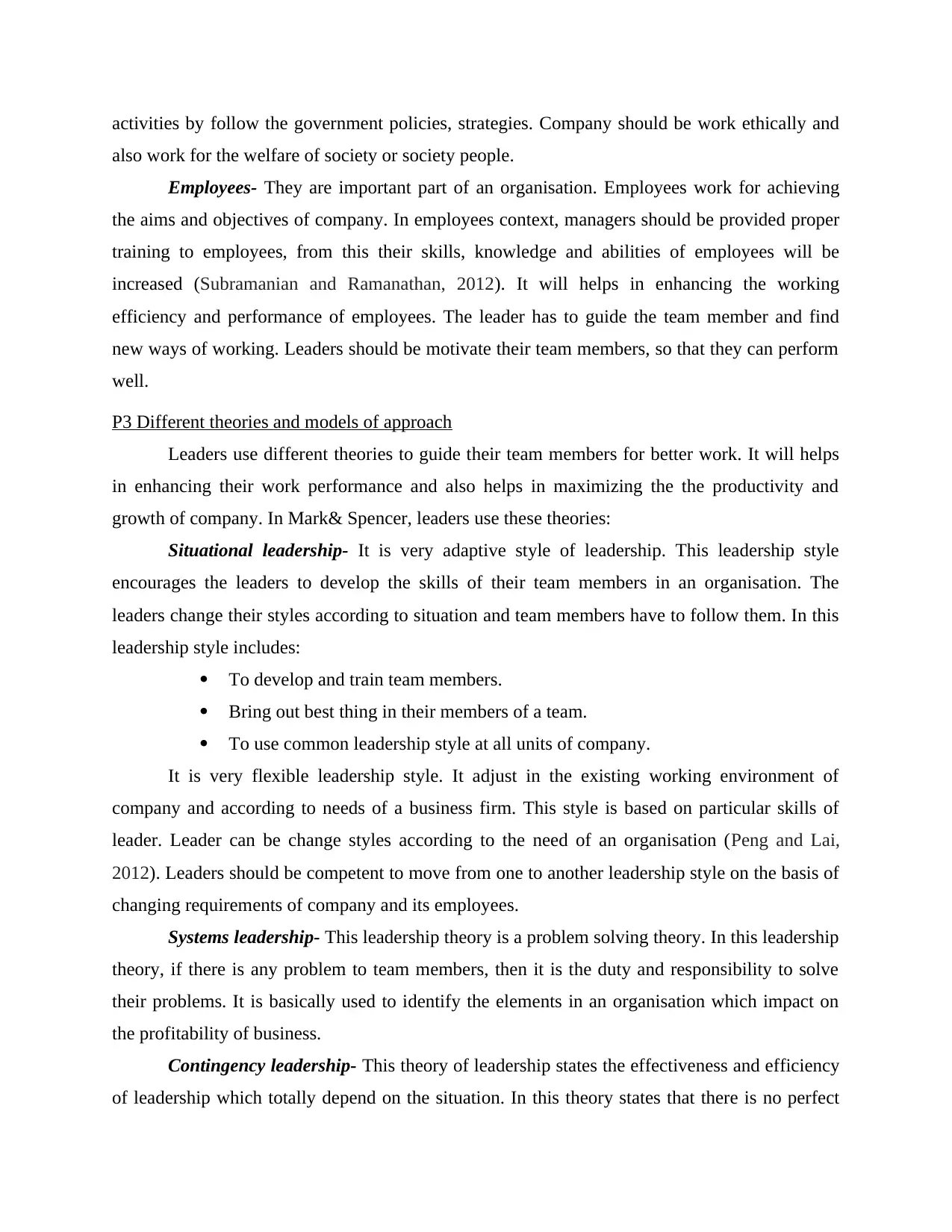
activities by follow the government policies, strategies. Company should be work ethically and
also work for the welfare of society or society people.
Employees- They are important part of an organisation. Employees work for achieving
the aims and objectives of company. In employees context, managers should be provided proper
training to employees, from this their skills, knowledge and abilities of employees will be
increased (Subramanian and Ramanathan, 2012). It will helps in enhancing the working
efficiency and performance of employees. The leader has to guide the team member and find
new ways of working. Leaders should be motivate their team members, so that they can perform
well.
P3 Different theories and models of approach
Leaders use different theories to guide their team members for better work. It will helps
in enhancing their work performance and also helps in maximizing the the productivity and
growth of company. In Mark& Spencer, leaders use these theories:
Situational leadership- It is very adaptive style of leadership. This leadership style
encourages the leaders to develop the skills of their team members in an organisation. The
leaders change their styles according to situation and team members have to follow them. In this
leadership style includes:
To develop and train team members.
Bring out best thing in their members of a team.
To use common leadership style at all units of company.
It is very flexible leadership style. It adjust in the existing working environment of
company and according to needs of a business firm. This style is based on particular skills of
leader. Leader can be change styles according to the need of an organisation (Peng and Lai,
2012). Leaders should be competent to move from one to another leadership style on the basis of
changing requirements of company and its employees.
Systems leadership- This leadership theory is a problem solving theory. In this leadership
theory, if there is any problem to team members, then it is the duty and responsibility to solve
their problems. It is basically used to identify the elements in an organisation which impact on
the profitability of business.
Contingency leadership- This theory of leadership states the effectiveness and efficiency
of leadership which totally depend on the situation. In this theory states that there is no perfect
also work for the welfare of society or society people.
Employees- They are important part of an organisation. Employees work for achieving
the aims and objectives of company. In employees context, managers should be provided proper
training to employees, from this their skills, knowledge and abilities of employees will be
increased (Subramanian and Ramanathan, 2012). It will helps in enhancing the working
efficiency and performance of employees. The leader has to guide the team member and find
new ways of working. Leaders should be motivate their team members, so that they can perform
well.
P3 Different theories and models of approach
Leaders use different theories to guide their team members for better work. It will helps
in enhancing their work performance and also helps in maximizing the the productivity and
growth of company. In Mark& Spencer, leaders use these theories:
Situational leadership- It is very adaptive style of leadership. This leadership style
encourages the leaders to develop the skills of their team members in an organisation. The
leaders change their styles according to situation and team members have to follow them. In this
leadership style includes:
To develop and train team members.
Bring out best thing in their members of a team.
To use common leadership style at all units of company.
It is very flexible leadership style. It adjust in the existing working environment of
company and according to needs of a business firm. This style is based on particular skills of
leader. Leader can be change styles according to the need of an organisation (Peng and Lai,
2012). Leaders should be competent to move from one to another leadership style on the basis of
changing requirements of company and its employees.
Systems leadership- This leadership theory is a problem solving theory. In this leadership
theory, if there is any problem to team members, then it is the duty and responsibility to solve
their problems. It is basically used to identify the elements in an organisation which impact on
the profitability of business.
Contingency leadership- This theory of leadership states the effectiveness and efficiency
of leadership which totally depend on the situation. In this theory states that there is no perfect
⊘ This is a preview!⊘
Do you want full access?
Subscribe today to unlock all pages.

Trusted by 1+ million students worldwide
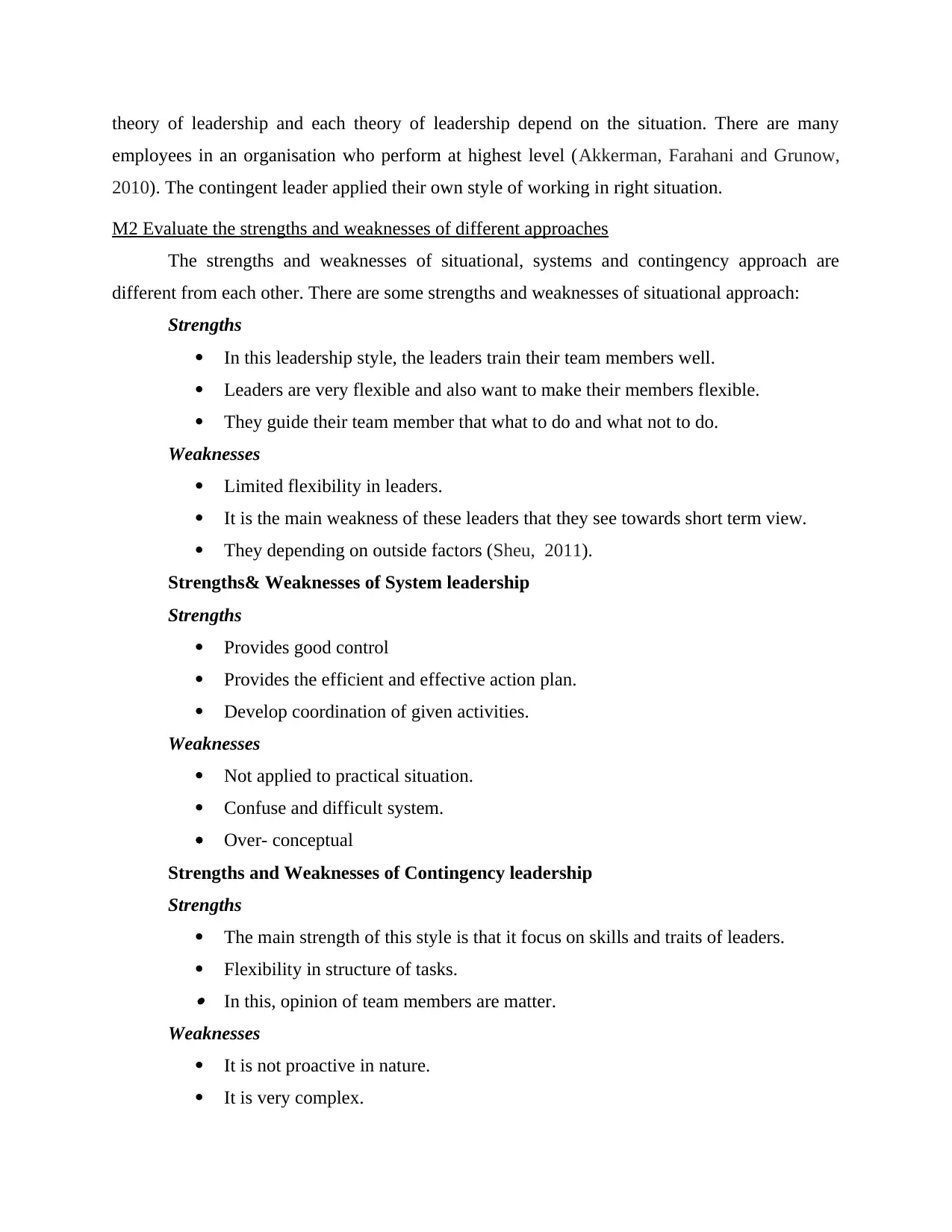
theory of leadership and each theory of leadership depend on the situation. There are many
employees in an organisation who perform at highest level (Akkerman, Farahani and Grunow,
2010). The contingent leader applied their own style of working in right situation.
M2 Evaluate the strengths and weaknesses of different approaches
The strengths and weaknesses of situational, systems and contingency approach are
different from each other. There are some strengths and weaknesses of situational approach:
Strengths
In this leadership style, the leaders train their team members well.
Leaders are very flexible and also want to make their members flexible.
They guide their team member that what to do and what not to do.
Weaknesses
Limited flexibility in leaders.
It is the main weakness of these leaders that they see towards short term view.
They depending on outside factors (Sheu, 2011).
Strengths& Weaknesses of System leadership
Strengths
Provides good control
Provides the efficient and effective action plan.
Develop coordination of given activities.
Weaknesses
Not applied to practical situation.
Confuse and difficult system.
Over- conceptual
Strengths and Weaknesses of Contingency leadership
Strengths
The main strength of this style is that it focus on skills and traits of leaders.
Flexibility in structure of tasks.
In this, opinion of team members are matter.
Weaknesses
It is not proactive in nature.
It is very complex.
employees in an organisation who perform at highest level (Akkerman, Farahani and Grunow,
2010). The contingent leader applied their own style of working in right situation.
M2 Evaluate the strengths and weaknesses of different approaches
The strengths and weaknesses of situational, systems and contingency approach are
different from each other. There are some strengths and weaknesses of situational approach:
Strengths
In this leadership style, the leaders train their team members well.
Leaders are very flexible and also want to make their members flexible.
They guide their team member that what to do and what not to do.
Weaknesses
Limited flexibility in leaders.
It is the main weakness of these leaders that they see towards short term view.
They depending on outside factors (Sheu, 2011).
Strengths& Weaknesses of System leadership
Strengths
Provides good control
Provides the efficient and effective action plan.
Develop coordination of given activities.
Weaknesses
Not applied to practical situation.
Confuse and difficult system.
Over- conceptual
Strengths and Weaknesses of Contingency leadership
Strengths
The main strength of this style is that it focus on skills and traits of leaders.
Flexibility in structure of tasks.
In this, opinion of team members are matter.
Weaknesses
It is not proactive in nature.
It is very complex.
Paraphrase This Document
Need a fresh take? Get an instant paraphrase of this document with our AI Paraphraser
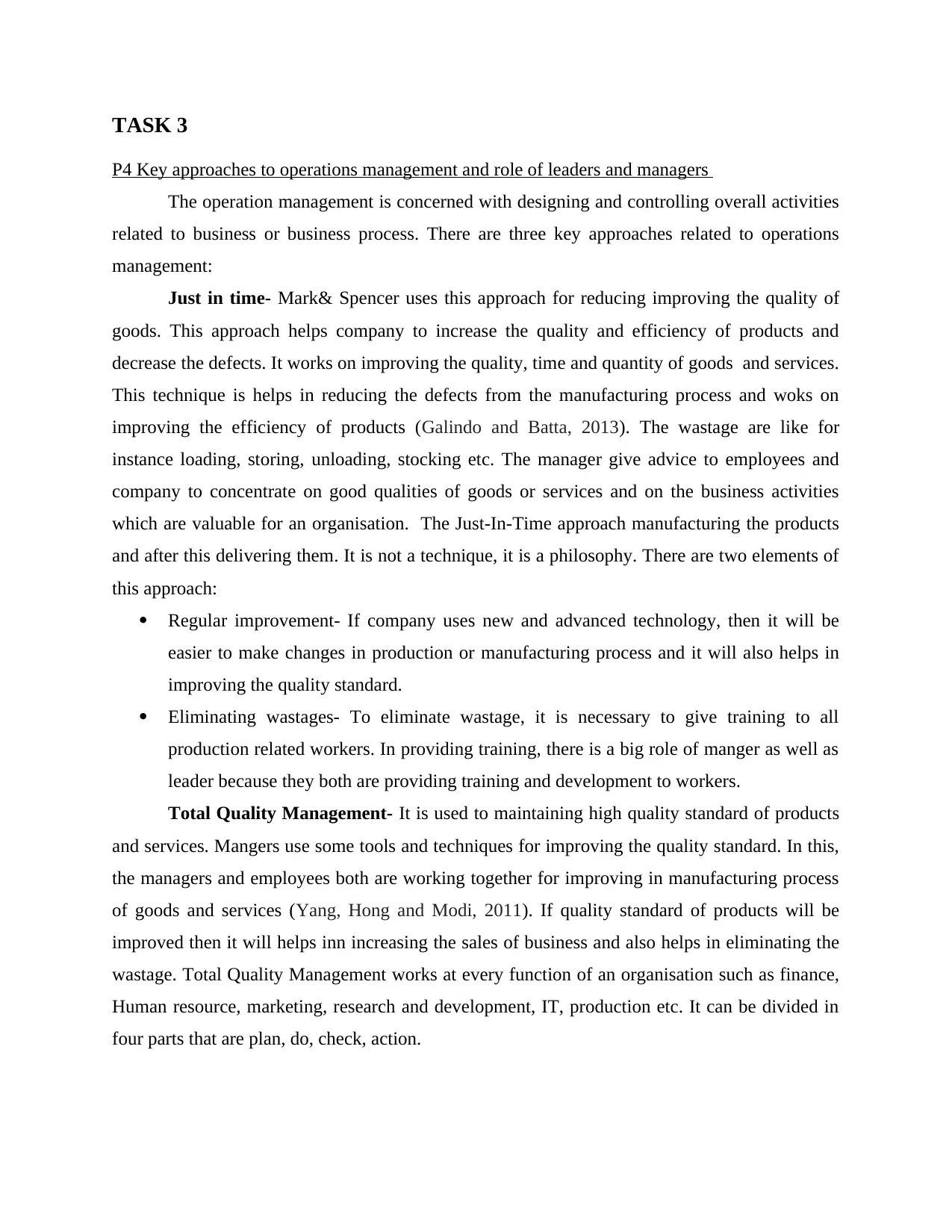
TASK 3
P4 Key approaches to operations management and role of leaders and managers
The operation management is concerned with designing and controlling overall activities
related to business or business process. There are three key approaches related to operations
management:
Just in time- Mark& Spencer uses this approach for reducing improving the quality of
goods. This approach helps company to increase the quality and efficiency of products and
decrease the defects. It works on improving the quality, time and quantity of goods and services.
This technique is helps in reducing the defects from the manufacturing process and woks on
improving the efficiency of products (Galindo and Batta, 2013). The wastage are like for
instance loading, storing, unloading, stocking etc. The manager give advice to employees and
company to concentrate on good qualities of goods or services and on the business activities
which are valuable for an organisation. The Just-In-Time approach manufacturing the products
and after this delivering them. It is not a technique, it is a philosophy. There are two elements of
this approach:
Regular improvement- If company uses new and advanced technology, then it will be
easier to make changes in production or manufacturing process and it will also helps in
improving the quality standard.
Eliminating wastages- To eliminate wastage, it is necessary to give training to all
production related workers. In providing training, there is a big role of manger as well as
leader because they both are providing training and development to workers.
Total Quality Management- It is used to maintaining high quality standard of products
and services. Mangers use some tools and techniques for improving the quality standard. In this,
the managers and employees both are working together for improving in manufacturing process
of goods and services (Yang, Hong and Modi, 2011). If quality standard of products will be
improved then it will helps inn increasing the sales of business and also helps in eliminating the
wastage. Total Quality Management works at every function of an organisation such as finance,
Human resource, marketing, research and development, IT, production etc. It can be divided in
four parts that are plan, do, check, action.
P4 Key approaches to operations management and role of leaders and managers
The operation management is concerned with designing and controlling overall activities
related to business or business process. There are three key approaches related to operations
management:
Just in time- Mark& Spencer uses this approach for reducing improving the quality of
goods. This approach helps company to increase the quality and efficiency of products and
decrease the defects. It works on improving the quality, time and quantity of goods and services.
This technique is helps in reducing the defects from the manufacturing process and woks on
improving the efficiency of products (Galindo and Batta, 2013). The wastage are like for
instance loading, storing, unloading, stocking etc. The manager give advice to employees and
company to concentrate on good qualities of goods or services and on the business activities
which are valuable for an organisation. The Just-In-Time approach manufacturing the products
and after this delivering them. It is not a technique, it is a philosophy. There are two elements of
this approach:
Regular improvement- If company uses new and advanced technology, then it will be
easier to make changes in production or manufacturing process and it will also helps in
improving the quality standard.
Eliminating wastages- To eliminate wastage, it is necessary to give training to all
production related workers. In providing training, there is a big role of manger as well as
leader because they both are providing training and development to workers.
Total Quality Management- It is used to maintaining high quality standard of products
and services. Mangers use some tools and techniques for improving the quality standard. In this,
the managers and employees both are working together for improving in manufacturing process
of goods and services (Yang, Hong and Modi, 2011). If quality standard of products will be
improved then it will helps inn increasing the sales of business and also helps in eliminating the
wastage. Total Quality Management works at every function of an organisation such as finance,
Human resource, marketing, research and development, IT, production etc. It can be divided in
four parts that are plan, do, check, action.
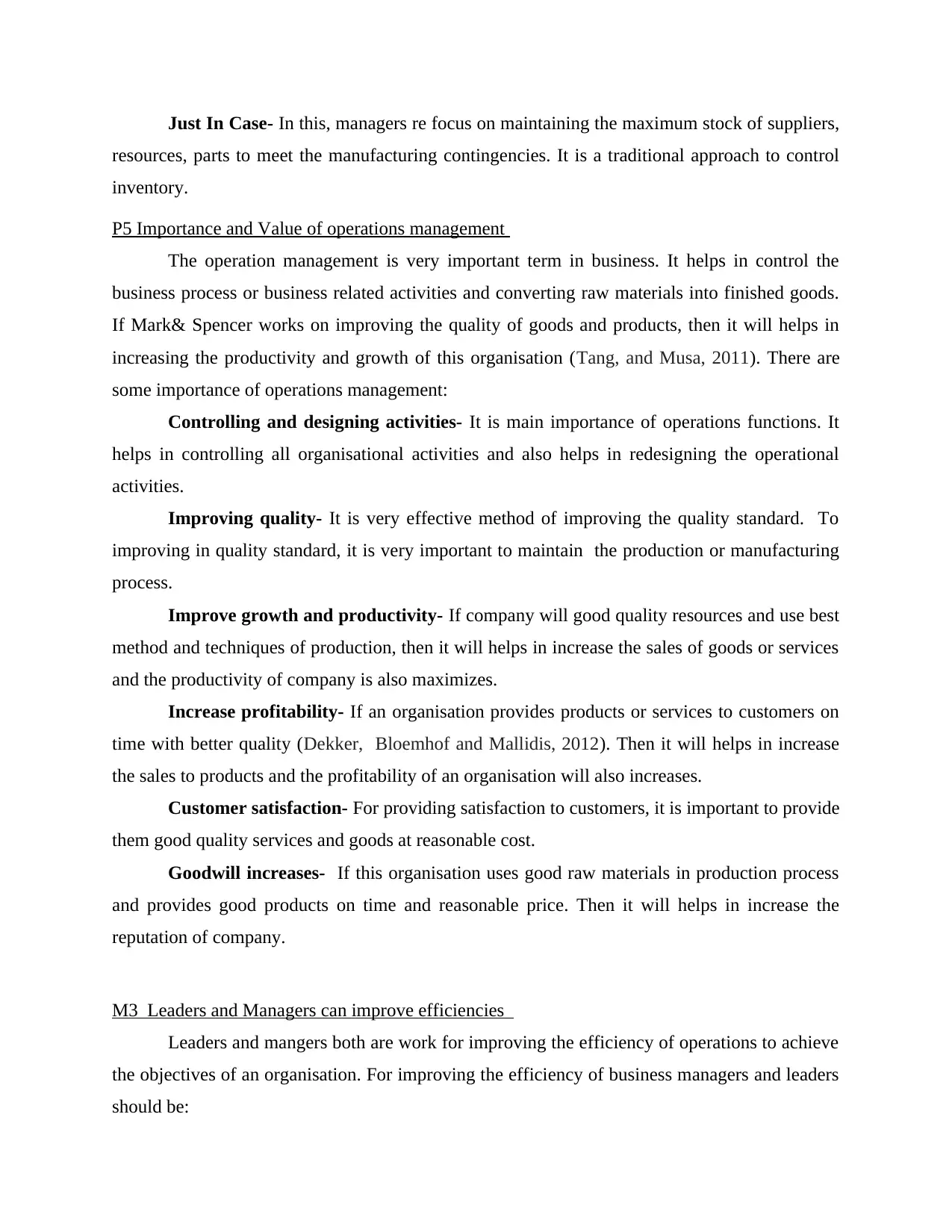
Just In Case- In this, managers re focus on maintaining the maximum stock of suppliers,
resources, parts to meet the manufacturing contingencies. It is a traditional approach to control
inventory.
P5 Importance and Value of operations management
The operation management is very important term in business. It helps in control the
business process or business related activities and converting raw materials into finished goods.
If Mark& Spencer works on improving the quality of goods and products, then it will helps in
increasing the productivity and growth of this organisation (Tang, and Musa, 2011). There are
some importance of operations management:
Controlling and designing activities- It is main importance of operations functions. It
helps in controlling all organisational activities and also helps in redesigning the operational
activities.
Improving quality- It is very effective method of improving the quality standard. To
improving in quality standard, it is very important to maintain the production or manufacturing
process.
Improve growth and productivity- If company will good quality resources and use best
method and techniques of production, then it will helps in increase the sales of goods or services
and the productivity of company is also maximizes.
Increase profitability- If an organisation provides products or services to customers on
time with better quality (Dekker, Bloemhof and Mallidis, 2012). Then it will helps in increase
the sales to products and the profitability of an organisation will also increases.
Customer satisfaction- For providing satisfaction to customers, it is important to provide
them good quality services and goods at reasonable cost.
Goodwill increases- If this organisation uses good raw materials in production process
and provides good products on time and reasonable price. Then it will helps in increase the
reputation of company.
M3 Leaders and Managers can improve efficiencies
Leaders and mangers both are work for improving the efficiency of operations to achieve
the objectives of an organisation. For improving the efficiency of business managers and leaders
should be:
resources, parts to meet the manufacturing contingencies. It is a traditional approach to control
inventory.
P5 Importance and Value of operations management
The operation management is very important term in business. It helps in control the
business process or business related activities and converting raw materials into finished goods.
If Mark& Spencer works on improving the quality of goods and products, then it will helps in
increasing the productivity and growth of this organisation (Tang, and Musa, 2011). There are
some importance of operations management:
Controlling and designing activities- It is main importance of operations functions. It
helps in controlling all organisational activities and also helps in redesigning the operational
activities.
Improving quality- It is very effective method of improving the quality standard. To
improving in quality standard, it is very important to maintain the production or manufacturing
process.
Improve growth and productivity- If company will good quality resources and use best
method and techniques of production, then it will helps in increase the sales of goods or services
and the productivity of company is also maximizes.
Increase profitability- If an organisation provides products or services to customers on
time with better quality (Dekker, Bloemhof and Mallidis, 2012). Then it will helps in increase
the sales to products and the profitability of an organisation will also increases.
Customer satisfaction- For providing satisfaction to customers, it is important to provide
them good quality services and goods at reasonable cost.
Goodwill increases- If this organisation uses good raw materials in production process
and provides good products on time and reasonable price. Then it will helps in increase the
reputation of company.
M3 Leaders and Managers can improve efficiencies
Leaders and mangers both are work for improving the efficiency of operations to achieve
the objectives of an organisation. For improving the efficiency of business managers and leaders
should be:
⊘ This is a preview!⊘
Do you want full access?
Subscribe today to unlock all pages.

Trusted by 1+ million students worldwide
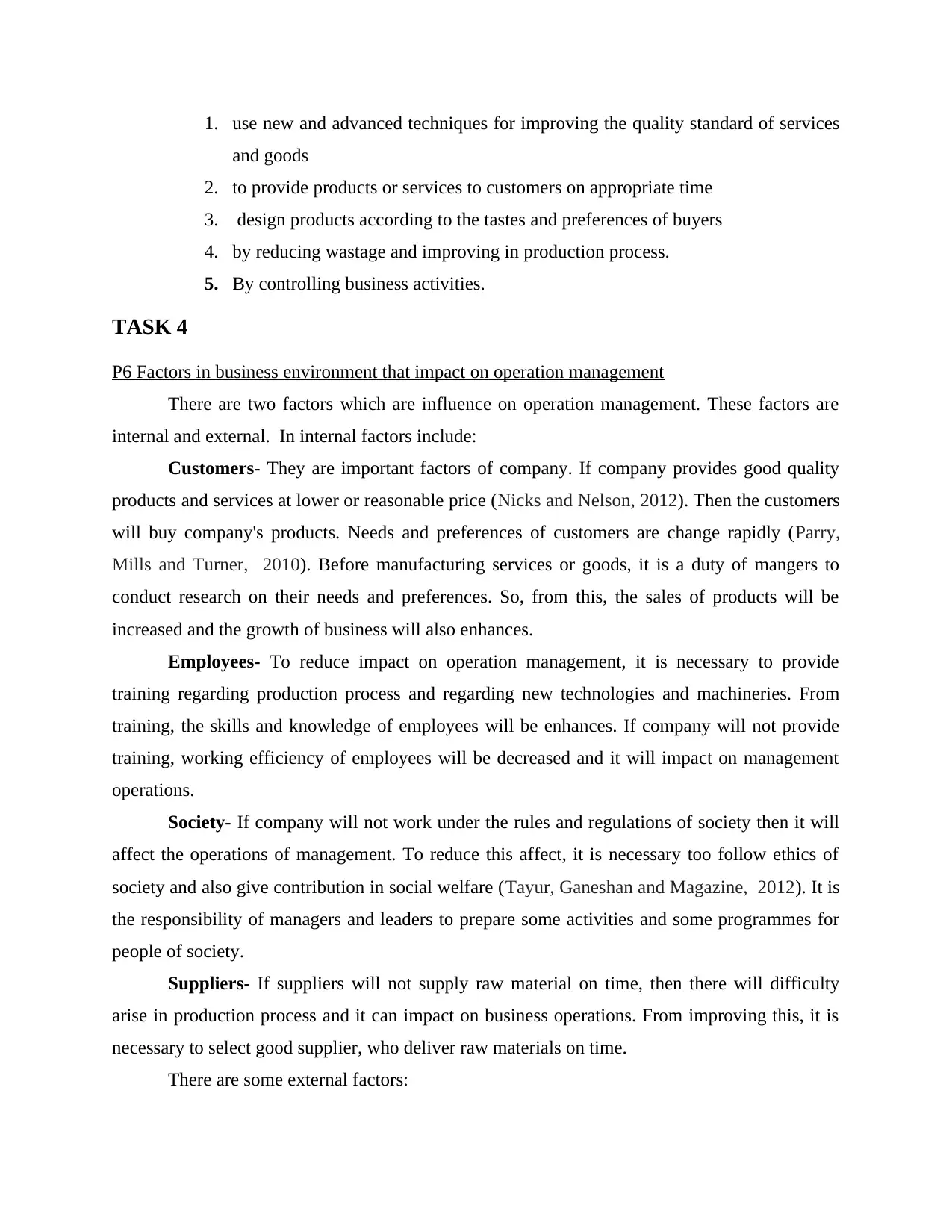
1. use new and advanced techniques for improving the quality standard of services
and goods
2. to provide products or services to customers on appropriate time
3. design products according to the tastes and preferences of buyers
4. by reducing wastage and improving in production process.
5. By controlling business activities.
TASK 4
P6 Factors in business environment that impact on operation management
There are two factors which are influence on operation management. These factors are
internal and external. In internal factors include:
Customers- They are important factors of company. If company provides good quality
products and services at lower or reasonable price (Nicks and Nelson, 2012). Then the customers
will buy company's products. Needs and preferences of customers are change rapidly (Parry,
Mills and Turner, 2010). Before manufacturing services or goods, it is a duty of mangers to
conduct research on their needs and preferences. So, from this, the sales of products will be
increased and the growth of business will also enhances.
Employees- To reduce impact on operation management, it is necessary to provide
training regarding production process and regarding new technologies and machineries. From
training, the skills and knowledge of employees will be enhances. If company will not provide
training, working efficiency of employees will be decreased and it will impact on management
operations.
Society- If company will not work under the rules and regulations of society then it will
affect the operations of management. To reduce this affect, it is necessary too follow ethics of
society and also give contribution in social welfare (Tayur, Ganeshan and Magazine, 2012). It is
the responsibility of managers and leaders to prepare some activities and some programmes for
people of society.
Suppliers- If suppliers will not supply raw material on time, then there will difficulty
arise in production process and it can impact on business operations. From improving this, it is
necessary to select good supplier, who deliver raw materials on time.
There are some external factors:
and goods
2. to provide products or services to customers on appropriate time
3. design products according to the tastes and preferences of buyers
4. by reducing wastage and improving in production process.
5. By controlling business activities.
TASK 4
P6 Factors in business environment that impact on operation management
There are two factors which are influence on operation management. These factors are
internal and external. In internal factors include:
Customers- They are important factors of company. If company provides good quality
products and services at lower or reasonable price (Nicks and Nelson, 2012). Then the customers
will buy company's products. Needs and preferences of customers are change rapidly (Parry,
Mills and Turner, 2010). Before manufacturing services or goods, it is a duty of mangers to
conduct research on their needs and preferences. So, from this, the sales of products will be
increased and the growth of business will also enhances.
Employees- To reduce impact on operation management, it is necessary to provide
training regarding production process and regarding new technologies and machineries. From
training, the skills and knowledge of employees will be enhances. If company will not provide
training, working efficiency of employees will be decreased and it will impact on management
operations.
Society- If company will not work under the rules and regulations of society then it will
affect the operations of management. To reduce this affect, it is necessary too follow ethics of
society and also give contribution in social welfare (Tayur, Ganeshan and Magazine, 2012). It is
the responsibility of managers and leaders to prepare some activities and some programmes for
people of society.
Suppliers- If suppliers will not supply raw material on time, then there will difficulty
arise in production process and it can impact on business operations. From improving this, it is
necessary to select good supplier, who deliver raw materials on time.
There are some external factors:
Paraphrase This Document
Need a fresh take? Get an instant paraphrase of this document with our AI Paraphraser
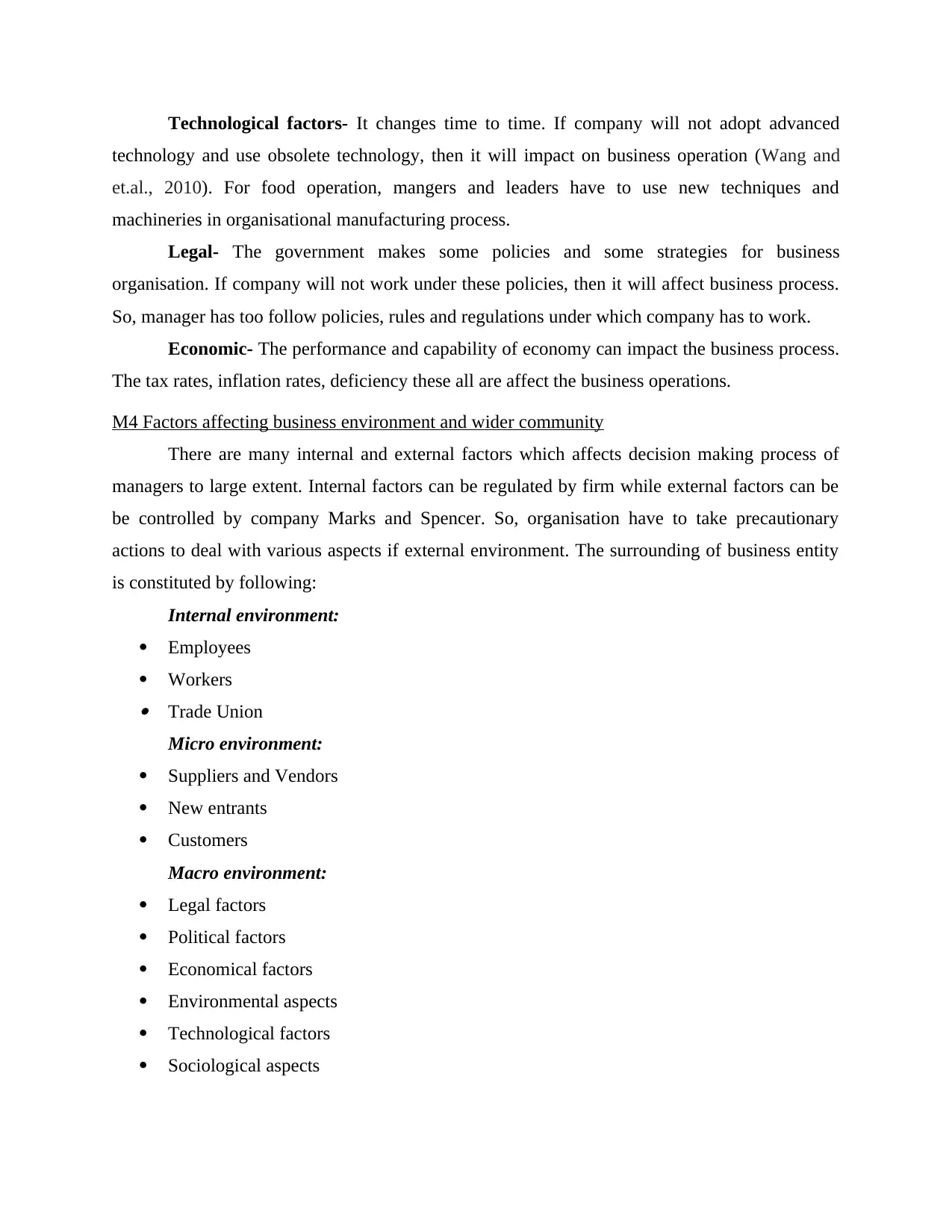
Technological factors- It changes time to time. If company will not adopt advanced
technology and use obsolete technology, then it will impact on business operation (Wang and
et.al., 2010). For food operation, mangers and leaders have to use new techniques and
machineries in organisational manufacturing process.
Legal- The government makes some policies and some strategies for business
organisation. If company will not work under these policies, then it will affect business process.
So, manager has too follow policies, rules and regulations under which company has to work.
Economic- The performance and capability of economy can impact the business process.
The tax rates, inflation rates, deficiency these all are affect the business operations.
M4 Factors affecting business environment and wider community
There are many internal and external factors which affects decision making process of
managers to large extent. Internal factors can be regulated by firm while external factors can be
be controlled by company Marks and Spencer. So, organisation have to take precautionary
actions to deal with various aspects if external environment. The surrounding of business entity
is constituted by following:
Internal environment:
Employees
Workers Trade Union
Micro environment:
Suppliers and Vendors
New entrants
Customers
Macro environment:
Legal factors
Political factors
Economical factors
Environmental aspects
Technological factors
Sociological aspects
technology and use obsolete technology, then it will impact on business operation (Wang and
et.al., 2010). For food operation, mangers and leaders have to use new techniques and
machineries in organisational manufacturing process.
Legal- The government makes some policies and some strategies for business
organisation. If company will not work under these policies, then it will affect business process.
So, manager has too follow policies, rules and regulations under which company has to work.
Economic- The performance and capability of economy can impact the business process.
The tax rates, inflation rates, deficiency these all are affect the business operations.
M4 Factors affecting business environment and wider community
There are many internal and external factors which affects decision making process of
managers to large extent. Internal factors can be regulated by firm while external factors can be
be controlled by company Marks and Spencer. So, organisation have to take precautionary
actions to deal with various aspects if external environment. The surrounding of business entity
is constituted by following:
Internal environment:
Employees
Workers Trade Union
Micro environment:
Suppliers and Vendors
New entrants
Customers
Macro environment:
Legal factors
Political factors
Economical factors
Environmental aspects
Technological factors
Sociological aspects
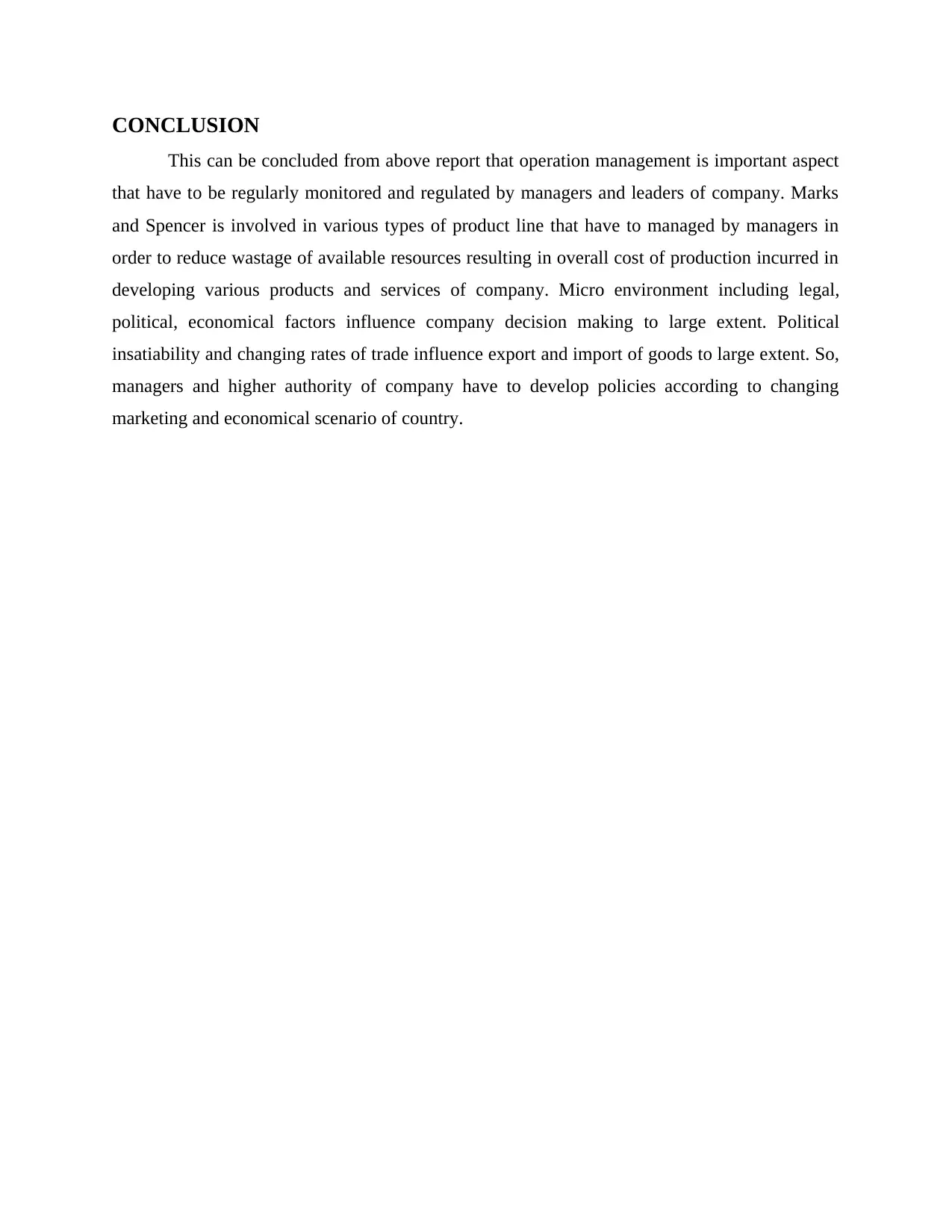
CONCLUSION
This can be concluded from above report that operation management is important aspect
that have to be regularly monitored and regulated by managers and leaders of company. Marks
and Spencer is involved in various types of product line that have to managed by managers in
order to reduce wastage of available resources resulting in overall cost of production incurred in
developing various products and services of company. Micro environment including legal,
political, economical factors influence company decision making to large extent. Political
insatiability and changing rates of trade influence export and import of goods to large extent. So,
managers and higher authority of company have to develop policies according to changing
marketing and economical scenario of country.
This can be concluded from above report that operation management is important aspect
that have to be regularly monitored and regulated by managers and leaders of company. Marks
and Spencer is involved in various types of product line that have to managed by managers in
order to reduce wastage of available resources resulting in overall cost of production incurred in
developing various products and services of company. Micro environment including legal,
political, economical factors influence company decision making to large extent. Political
insatiability and changing rates of trade influence export and import of goods to large extent. So,
managers and higher authority of company have to develop policies according to changing
marketing and economical scenario of country.
⊘ This is a preview!⊘
Do you want full access?
Subscribe today to unlock all pages.

Trusted by 1+ million students worldwide
1 out of 14
Related Documents
Your All-in-One AI-Powered Toolkit for Academic Success.
+13062052269
info@desklib.com
Available 24*7 on WhatsApp / Email
![[object Object]](/_next/static/media/star-bottom.7253800d.svg)
Unlock your academic potential
Copyright © 2020–2025 A2Z Services. All Rights Reserved. Developed and managed by ZUCOL.





